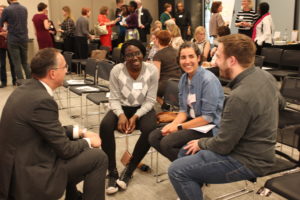When Voice At The Table was first set up, it was with the aim of changing corporate culture by empowering women to be authentic and forthright. We very quickly discovered that the challenge was not empowering women but creating a work environment that appreciates and welcomes these empowered women. As a result, much of our work nowadays focuses on culture change. We work with organisations to develop inclusive teams and leaders by challenging existing beliefs and – more importantly – behaviours.
One question that pops up regularly is how to persuade sceptics about the virtues and business imperative of the D&I agenda.
The answer to this question is quite simple: don’t!
Let us explain.
How change spreads across our culture
The Diffusion of Innovations is a theory that attempts to explain how and why new ideas and technologies spread and become mainstream, and at what rate this occurs. This theory became widely known after a Communication Studies professor called Everett Rogers published a book with the same name in 1962. Rogers stated that diffusion is the way in which an innovation is communicated over time among the members of a social system. The best-known element of this work is the Innovation-Adaptation Curve (pictured), which illustrates the rate of adoption of a product or idea until it is widely adopted reaches a critical mass that is self-sustaining.

Not everyone will get on board with D&I straight away; 20% will probably never come along and we shouldn’t worry about that, because we simply cannot change everyone. The “Laggards” may never subscribe to the benefits of greater Diversity and Inclusion in our organisations, but as behaviour and culture change progresses through the Curve, the numbers of these so-called sceptics dwindles.
What we should focus on is creating a momentum of behaviour change that carries the “Late Majority” along with the tide, creating a place to work where the majority of its people, systems and policies are aligned with the principles of Diversity and Inclusion. It is this momentum that we need to worry about and continue to measure. As long as we keep moving through the Innovation-Adoption Curve, we’re making good progress.
The way to create this momentum is to focus initially on those receptive to the ideology of Diversity and Inclusion: the champions, allies and listeners – the D&I Innovators, Early Adopters and the Early Majority. Those who are struggling to see the need for change are unlikely to be converted.
Diversity and Inclusion is swiftly becoming more mainstream and centre stage, far more than it was only five years ago. It is being talked about in the press, in discussion pieces and in mainstream reporting about senior leaders who are out-of-date with the current zeitgeist and have made complacent sexist or racist comments that have ultimately cost them their jobs. Consequently, it is becoming more and more difficult for senior leaders to resist the changes that are taking place. So let’s focus our energy on continuing to build the momentum with those leaders who share our vision of the future of business and let the ‘Laggards’ come to their own conclusions.



 You can improve your business performance and everyone’s job satisfaction, simply by hearing more from people who aren’t usually heard. When people feel included and valued, their levels of engagement and motivation rise and they more readily bring fresh ideas and innovation which boosts their sense of ownership of the business objectives.
You can improve your business performance and everyone’s job satisfaction, simply by hearing more from people who aren’t usually heard. When people feel included and valued, their levels of engagement and motivation rise and they more readily bring fresh ideas and innovation which boosts their sense of ownership of the business objectives.
